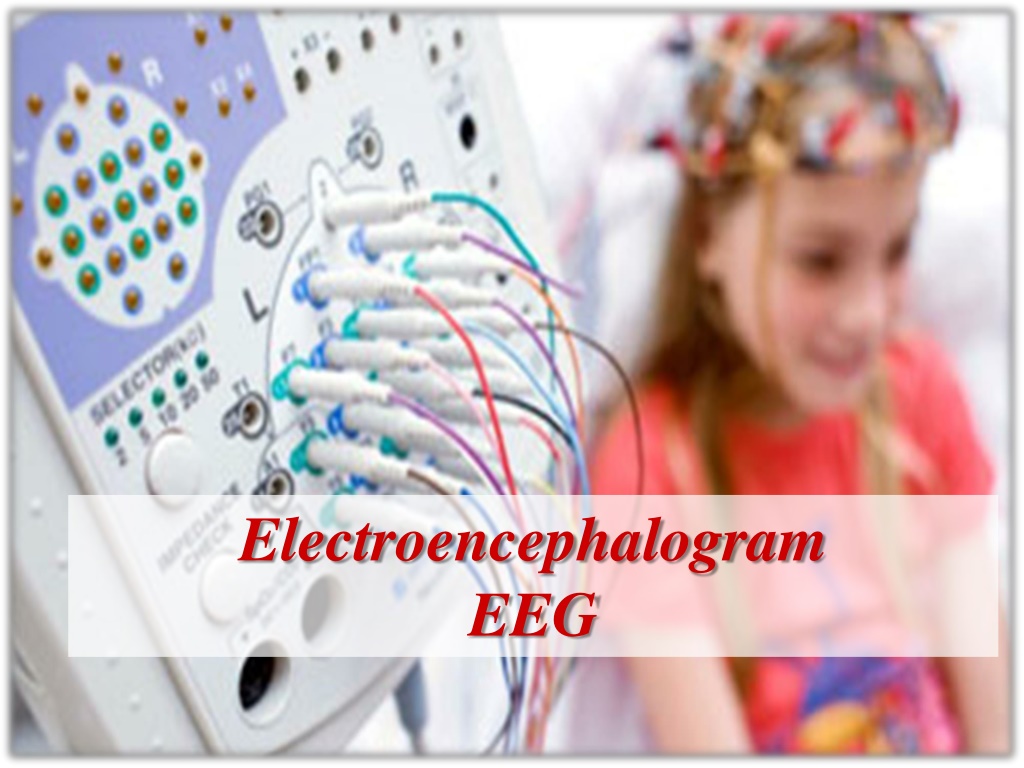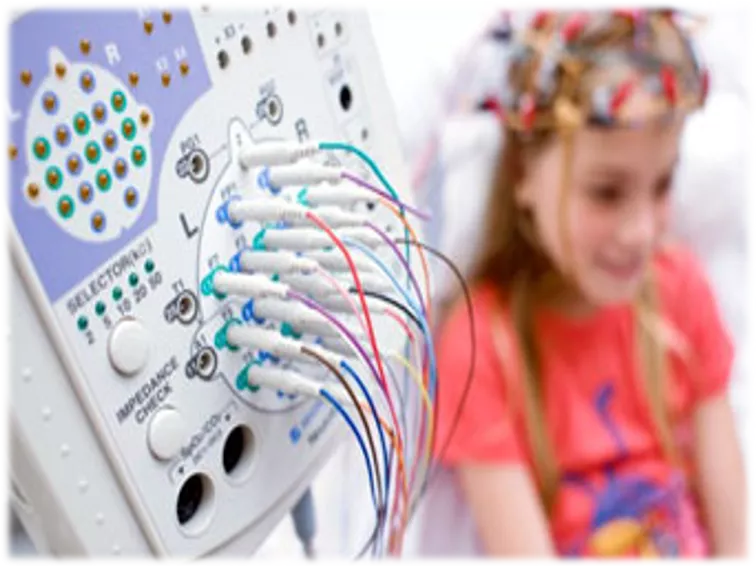Electroencephalogram
The Electroencephalogram (EEG) is a medical test used to measure the electrical activity of the brain. Electrodes are attached to the scalp to record brain waves, providing valuable information for diagnosing seizure disorders, epilepsy, coma, and more. Learn about the purpose, procedure, and nursing interventions involved in EEG testing. Discover where and why EEGs are performed, common factors affecting results, and potential complications. Dive into the world of neurological diagnostic tests and gain insights into managing patients undergoing EEGs.
Download Presentation

Please find below an Image/Link to download the presentation.
The content on the website is provided AS IS for your information and personal use only. It may not be sold, licensed, or shared on other websites without obtaining consent from the author.If you encounter any issues during the download, it is possible that the publisher has removed the file from their server.
You are allowed to download the files provided on this website for personal or commercial use, subject to the condition that they are used lawfully. All files are the property of their respective owners.
The content on the website is provided AS IS for your information and personal use only. It may not be sold, licensed, or shared on other websites without obtaining consent from the author.
E N D
Presentation Transcript
Outline; EEG Overview. Purpose Indications Type of EEG Tests Nursing Interventions; * Patient Preparation. * Patient and Family Teaching. Normal / Abnormal Results Common Factors affecting EEG Recording Complications.
Objectives At the end of the lecture, the students will be able to Understand EEG procedure. Discuss nursing management.
Diagnostic Tests for Neurological Diseases Brain scans Cerobrospinal fluid analysis Computed Tomography (CT scan), Echocardiogram Electroencephalography (EEG)
The Electroencephalogram (EEG) Definition: Is a medical test used to measure the electrical activity of the brain, via electrodes applied to scalp or through microelectrodes placed within the brain tissue
Electrodes are attached to multiple sites on the scalp to provide a recording of electrical activity that is generated in the cerebral cortex. Electrical impulses are transmitted to an electroencephalograph, which magnifies and records these impulses as brain waves on a strip of paper.
PURPOSE 1. 2. It provides a physiologic assessment of cerebral activity. for diagnosing and evaluating seizure disorders, epilepsy, coma, or organic brain syndrome, sleep disorders. Used in making a determination of brain death used in intensive care units for brain function monitoring A. non-convulsive seizures/non-convulsive status epilepticus B. effect of sedative/anesthesia in patients in medically induced coma (for treatment of refractory seizures or increased intracranial pressure) C. secondary brain damage in conditions such as subarachnoid hemorrhage 3. 4.
Where is it performed? room with no electrical interference; bedside - comatose patient (using a portable unit.) The test takes about 1 to 2 hour. completely painless , no need for shaving the hair. Provides information about the timing of events. Indication: epilepsy, coma, sleep disorders, confirmation of brain death Tumors, brain abscesses, blood clots, and infection may cause abnormal patterns in electrical activity.
For a baseline recording, the patient is instructed to 1. lie quietly with both eyes closed ( resting phase) 2. hyperventilate for 3 to 4 minutes and then look at a bright, flashing light for stimulation. ( activation procedures) to evoke abnormal electrical discharges, such as seizure potentials.
During the recording, a series of activation procedures may be used. These procedures may induce normal or abnormal EEG activity that might not otherwise be seen. (hyperventilation, photic stimulation (with a strobe light), eye closure, mental activity, sleep and sleep deprivation). A sleep EEG may be recorded after sedation because some abnormal brain waves are seen only when the patient is asleep.
Types of EEG test: 1. Routine EEG tests - EEG test done at an outpatient s appointment at the hospital ( lasts about one hour) 2. Ambulatory EEG test- recording the activity in the brain over a few hours, days or weeks, allowing more time for the test to pick up any unusual electrical activity in the brain, the electrodes are plugged in to a small monitor that records the results. 3. Sleep EEG tests - an EEG test is done while the patient is asleep, usually done in hospital, using a routine EEG machine. Before the test, the patient may be given some medicine to induce sleep. The test lasts for one to two hours or up to 8 hours Patient goes home once he wakes up 4. Sleep-deprived EEG tests - done when a patient had less sleep than usual. Before a sleep-deprived EEG test, the patient is advised not to go to sleep at all the night before, or just to wake up much earlier than usual. A patient tries to fall asleep or doze while the EEG is still recording the activity in the brain. The test lasts for a few hours. Patient goes home once he wakes up
Types of EEG test: 5. Video-telemetry tests a patient wears an ambulatory EEG usually carried out over a few days. All movements are recorded by a video camera. The patient need to stay in hospital This is done if a patient have already been diagnosed with epilepsy to determine the following: To determine the type of seizures The reason / cause why anti-epileptic drugs are not working well Other possibility that the seizures are caused by other etiology than epilepsy. considering having epilepsy surgery. a. b. c. d.
Nursing Interventions A- Patient Preparation; 1) Explain the procedure to the patients, emphasizing the importance of cooperation. 2) Withhold Antiseizure agents, tranquilizers, stimulants, and depressants medications for 24 to 48 hours before an EEG (alters the EEG wave patterns or mask the abnormal wave patterns of seizure disorders) 3) NO coffee, tea, chocolate, and cola drinks in the meal before the test (stimulants)
4) Have regular meal before the EEG ( to avoid alteration of blood glucose level. Low blood sugar can cause changes in the brain wave patterns and change the EEG result) 5) Assure the patient that the procedure does not cause an electric shock and that the EEG is a diagnostic test, not a form of treatment. 6) Patients with seizures do not stop taking their antiseizure medication prior to testing. 7) Assist the patient to wash the hair before and after the test.
B- Patient and Family Teaching 1) The test takes about 1 to 2 hour. 2) The test is painless and will be performed while sitting in a comfortable chair or lying on a stretcher. 3) The electrodes are applied to the scalp with a thick paste. 4) During the test, the patient will first be asked to breathe in and out deeply for a few minutes. Then, close her eyes while a light is flashed on them and, finally, the patient will lie quietly with her eyes closed. 5) After the test, the nurse will help the patient wash the paste out of the patient s hair.
Normal Results Brain electrical activity has certain frequencies (the number of waves per second) that are normal for different levels of consciousness. For example, brain waves are faster when the person is awake, and slower when he/she is sleeping. There are also normal patterns to these waves. The frequencies and patterns are what the EEG reader looks for. Note: A normal EEG does not mean that a seizure did not occur
Abnormal Results Abnormal results on an EEG test may be due to: An abnormal structure in the brain (such as a brain tumor) Attention problems Tissue death due to a blockage in blood flow (cerebral infarction) Drug or alcohol abuse Head injury Inflammation of the brain (encephalitis) Hemorrhage (abnormal bleeding caused by a ruptured blood vessel) Migraines (in some cases) Seizure disorder (such as epilepsy or convulsions) Sleep disorder (such as narcolepsy)
Common factors affecting EEG recording ( artifacts) The biggest challenge with monitoring EEG is artifact recognition and elimination. A. There are patient related artifacts (e.g. movement, sweating, ECG, eye movements) B. technical artifacts (cable movements, electrode paste-related), which have to be handled differently. Common factors are: Radio frequency (RF) waves Electromagnetic interference Eye movement ECG Head movement Muscle Sweating Electrode
Complications EEG is a safe test with no side effects. However, a person with epilepsy may experience a seizure, triggered by the various stimuli used in the procedure, including the flashing lights. This is not seen as a 'complication' by medical staff, because a seizure during an EEG can greatly help in diagnosis.)






